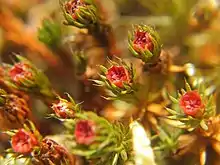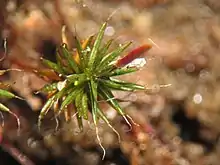Polytrichum piliferum
Polytrichum piliferum, the bristly haircap, is an evergreen perennial species of moss in the family Polytrichaceae.[2] The bristly haircap moss is small-sized to medium-sized and forms loose tufts[3] with wine-reddish stems.[4] It is an acrocarpous moss that appears bluish-green to grey.[5] This moss grows in clumps on erect shoots and becomes a red-brown colour as it grows older.[6] The most distinguishing feature of P. piliferum is the long, white awn at the tips of the leaves, which also give this moss its grey colour.[5] It is the only species in its genus where the awn is completely hyaline.[6]
| Polytrichum piliferum | |
|---|---|
_7699.jpg.webp) | |
| Scientific classification | |
| Kingdom: | Plantae |
| Division: | Bryophyta |
| Class: | Polytrichopsida |
| Order: | Polytrichales |
| Family: | Polytrichaceae |
| Genus: | Polytrichum |
| Species: | P. piliferum |
| Binomial name | |
| Polytrichum piliferum Hedw. | |
| Synonyms[1] | |
|
Synonyms
| |
Common names
In English the species goes by the common names polytrichum moss, bristly haircap,[7] or bristly haircap moss. In Finnish its common name is karvakarhunsammal, while in German it is called Glashaar-Frauenhaarmoos, Glashaar-Haarmützenmoos, Glashaar-Widertonmoos, Haartragendes Frauenhaar-Moos, or Haartragendes Frauenhaarmoos.[2]
Distribution
Polytrichum piliferum has a bipolar, cosmopolitan distribution, occurring in suitable habitats on all continents[2][8] including Antarctica.[9]: 39 P. piliferum is less common than Polytrichum juniperinum[7] and it often occurs in association with species of Cladonia.[3] In sandy dry grass lands the species prevents higher plants from growing.[10]
Habitat
It is found in similar habitats to Polytrichum juniperinum,[7] however, P. piliferum prefers more open and exposed areas. [11]: 324 P. piliferum also prefers a drier environment [6] and is able to withstand temperatures as high as 90°C to 100°C.[12] P. piliferum can also be frequently found in areas that are acidic and low in nutrients, therefore, they can be an excellent gauge for nutrient levels. [5]
The habitat of P. piliferum includes shallow soil over outcrops, exposed sandy soils of banks, gravel cover, and disturbed areas.[5] Other habitats of P. piliferum includes rocks on road banks or pastures.[13] It is also found in shallow and drained sand or gravel, like in ground over rocks and boulders.[3]
Reproduction
P. piliferum is dioicous, meaning that it has separate male and female plants.[3] To sexually reproduce, this moss utilizes the splash-cup mechanism to disperse the sperm it produces from its antheridia. The splash-cup mechanism occurs when raindrops splash onto the antheridia, collect sperm, and are hopefully splashed onto the female plant, where the sperm can swim to the archegonia.[14]
Gametophytic characteristics
Overall structure
Polytrichum piliferum grows close to the ground (about 4 cm or less) and forms dense clusters near the tip of the shoot, forcing the stem to be somewhat bare.[11] The stem is tall, wiry, unbranched, and a dark-red colour.[3] The calyptra of P. piliferum is hairy and a whitish-brown color.[3]
Leaf structure
_5598.JPG.webp)


In P. piliferum, shorter leaves are located close together towards the tip of its red stems, giving the shoot a characteristic tapered shape.[7] The leaves have a distinct white, hair-like awn at the leaf tip, in contrast to the short red-brown awns of P. juniperinum. These leaves can be anywhere from 4 mm to 7 mm long,[13] although they may be shorter in dry areas.[6] The leaves of P. piliferum are costate and often stand erect, straight, and slightly in-curved when dry, and erect-spreading when moist.[3]
Polytrichum piliferum leaves possess parallel, longitudinal lamellae of photosynthetic tissue on their upper surfaces, which are a unique characteristic associated with the Polytrichopsida.[14] Another distinguishing feature of P. piliferum are the in-curved leaf blades over the photosynthetic lamellae.[15] The topmost cells of the lamellae in P. piliferum are smooth,[5] and under a microscope, the cross section of each lamella appears 1 cell wide and 5 to 7 cells high.[13]
Sporophytic characteristics
The sporophytes of P. piliferum are common and usually reach maturity during the summer.[5] The sporangia are cube-like and inclined, but become more horizontal when mature.[3] They are borne on the red-brown seta that is approximately 1 cm to 3 cm in height.[3]
Conservation status
P. piliferum is ranked globally as secure (G5) as of 1/26/2015,[17] meaning that this species is at a very low risk of becoming globally extinct due to an abundant population.[18] In Canada, Polytrichum pilifeurm is ranked as secure (N5),[17] meaning that this species has a very low risk of becoming extinct in Canada due to a high presence in an extensive habitat.[18]
References
- "Polytrichum piliferum". The Plant List. Royal Botanic Garden Kew and Missouri Botanic Garden. 2013. Retrieved 8 October 2021.
- "Polytrichum moss - Encyclopedia of Life". eol.org. Retrieved 2021-10-05.
- "Polytrichum piliferum in Flora of North America @ efloras.org". www.efloras.org. Retrieved 2021-10-06.
- "E-Flora BC Atlas Page". linnet.geog.ubc.ca. Retrieved 2022-04-08.
- "Polytrichum piliferum | Introduction to Bryophytes". Retrieved 2022-02-11.
- Webmaster, David Ratz. "Frosted Haircap Moss - Montana Field Guide". fieldguide.mt.gov. Retrieved 2021-10-06.
- Watson, EV (1981). British Mosses and Liverworts: An Introductory Work (3 ed.). Cambridge University Press. p. 148. ISBN 978-0-521-28536-0.
- Ros, Rosa María; Cano, María J.; Guerra, Juan (1999). "Bryophyte checklist of Northern Africa". Journal of Bryology. 21 (3): 207–244. doi:10.1179/jbr.1999.21.3.207.
- Putzke, J.; Pereira, A.B. (2001). The Antarctic mosses with special reference to the South Shetland Islands. Brazil: Ed. Ulbra. ISBN 85-7528-008-2.
- Leuschner, Christoph; Ellenberg, Heinz (2017-09-13). Ecology of Central European Non-Forest Vegetation: Coastal to Alpine, Natural to Man-Made Habitats: Vegetation Ecology of Central Europe, Volume II. Springer. p. 569. ISBN 978-3-319-43048-5.
- Atherton, I; Bosanquet, S; Lawley, M, eds. (2010). Mosses and liverworts of Britain and Ireland, a field guide (PDF). Plymouth, UK: British Bryological Society Publications. ISBN 978-0-9561310-1-0.
- Stoutjesdijk, Ph; Barkman, J. J. (2014-12-01). Microclimate, Vegetation & Fauna. BRILL. p. 152. ISBN 978-90-04-29780-7.
- McKnight, Karl B.; Rohrer, Joseph R.; Ward, Kirsten McKnight; Perdrizet, Warren J. (2013-02-21). Common Mosses of the Northeast and Appalachians. Princeton University Press. p. 65. ISBN 978-1-4008-4588-0.
- "Class Polytrichopsida | Introduction to Bryophytes". Retrieved 2022-04-08.
- "E-Flora BC Atlas Page". linnet.geog.ubc.ca. Retrieved 2022-04-08.
- Goffinet, Bernard (2008-10-30). Bryophyte Biology. Cambridge University Press. p. 76. ISBN 978-1-107-37728-8.
- "NatureServe Explorer 2.0". explorer.natureserve.org. Retrieved 2022-04-11.
- "NatureServe Explorer 2.0". explorer.natureserve.org. Retrieved 2022-04-11.